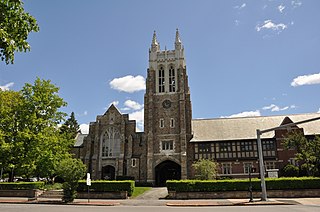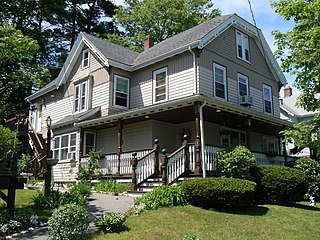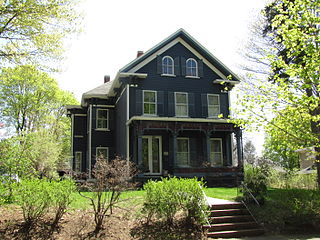
Auburndale is one of the thirteen villages within the city of Newton in Middlesex County, Massachusetts, United States. It lies at the western end of Newton near the intersection of interstate highways 90 and 95. It is bisected by the Massachusetts Turnpike. Auburndale is surrounded by three other Newton villages as well as the city of Waltham and the Charles River. Auburndale is the home of Williams and Burr elementary schools, as well as Lasell College. Auburndale Square is the location of the Plummer Memorial Library, which is run by the Auburndale Community Library and no longer affiliated with the Newton Free Library, the Turtle Lane Playhouse, and many small businesses.

Newton Highlands is one of the thirteen villages within the city of Newton in Middlesex County, Massachusetts, United States. The Newton Highlands Historic District includes residential and commercial businesses back to the late 19th century.

The First Unitarian Universalist Society in Newton occupies a prominent location at 1326 Washington Street in the heart of the village of West Newton in Newton, Massachusetts. Architect Ralph Adams Cram designed the church, Frederick Law Olmsted Jr. designed the grounds, the cornerstone was laid in 1905, and it was dedicated in 1906; it is one of the village's oldest buildings. The church is in Cram's signature Gothic Revival style, with buttressed walls and a blocky square tower with crenellations and spires. An enclosed courtyard is formed by an office wing, banquet hall, and parish house, which are built to resemble Elizabethan architecture with brick first floor and half-timbered upper level.

The Newtonville Historic District is a historic district in the village of Newtonville, in Newton, Massachusetts. The district encompasses the southern portion of the village's business district, as well as surrounding residential areas. It was listed on the National Register of Historic Places in 1986, and enlarged in 1990.

The Charles Riley House is a historic house in Newton, Massachusetts. This large neo-Classical estate house started out as a more modest wood-frame structure built in the 1870s by Boston businessman Job Turner. In c. 1888 Charles Riley, a manufacturer of cotton processing machinery, greatly expanded the house, giving it the present neo-Classical styling, and finishing the exterior in brick and stone.

The Newton Lamson House is a historic house at 33 Chestnut Street in the Nobility Hill section of Stoneham, Massachusetts. Built c. 1887, it is one of Stoneham's finest Queen Anne/Stick style houses. It has a rectangular plan, with a gable roof that has a cross gable centered on the south side. The gable ends are clad in decorative cut shingles, and the gables are decorated with Stick-style vergeboard elements. Below the eaves hangs a decorative wave-patterned valance. The porch has turned posts and balusters. It is further enhanced by its position in the center of a group of stylish period houses, including the Sidney A. Hill House and the Franklin B. Jenkins House.

The Charles Newton House is a historic house at 24 Brattle Street in Worcester, Massachusetts.

15 Wave Avenue is a well-preserved Italianate style house in Wakefield, Massachusetts. It was built between 1875 and 1883, and was listed on the National Register of Historic Places on July 6, 1989.

The Gray Cliff Historic District is a residential historic district encompassing a cluster of exceptionally high quality houses built in Newton, Massachusetts, between about 1890 and 1940. When first listed on the National Register of Historic Places in 1986, it included only the eight houses at 35, 39, 43, 53, 54, 64, 65, and 70 Gray Cliff Road, which were predominantly Shingle style house built before the turn of the 20th century. The district was expanded in 1990 to include an adjacent area known as The Ledges, where the houses were built between 1900 and 1940, and are mainly Colonial Revival and Tudor Revival in their styling.

The house at 173–175 Ward Street in Newton, Massachusetts is one of the city's few federal style houses. Built c. 1800, it is a 2+1⁄2-story wood-frame structure with clapboard siding and twin rear wall chimneys. The house has a five-bay facade with windows framed by narrow moulding. The main entrance is flanked by paired pilasters surrounding sidelight windows, topped by an entablature. The house was built by Charles Hyde and was involved in property disputes attending the construction of tunnels in the area in the mid-19th century.

The Eleazer Hyde House is a historic house located at 401 Woodward Street in Newton, Massachusetts.

The Lasell Neighborhood Historic District is a historic district roughly bounded by Woodland, Studio Roads, Aspen, Seminary Avenue, and Grove Street in Newton, Massachusetts - a village of Auburndale, Massachusetts. The area includes high-quality late - 19th and early - 20th century housing built in the area and includes buildings on the campus of Lasell University, established as the Auburndale Female Seminary in 1851. The district was listed on the National Register of Historic Places in 1986.

The Charles W. Noyes House is a historic single-family bungalow located at 271 Chestnut Street in the village of West Newton in Newton, Massachusetts. It was built in 1914 and was designed in the American Craftsman style of architecture by Boston-based architect Hubert G. Ripley of Ripley & Le Boutillier. It is 1+1⁄2 stories in height, with a stuccoed exterior and a broad, shallow-pitched, clipped-gable roof. The street-facing façade has banks of small-paned windows at each level. It was owned by a lawyer named Charles W. Noyes.

The Pine Ridge Road–Plainfield Street Historic District encompasses a residential subdivision in the Waban section of Newton, Massachusetts. It includes 44 properties on Pine Ridge Road and Plainfield Street between Chestnut Street and Upland Road, and includes a few properties on the latter two streets. The area was laid out for development in the 1880s after the arrival of suburban rail service, and was built out by the 1930s. The district was listed on the National Register of Historic Places in 1990.

The Second C. A. Sawyer House is a historic house at 86 Waban Ave. in Newton, Massachusetts. The 2+1⁄2-story brick building was designed by Derby and Robinson and built in 1919. It is a well-executed example of Colonial Revival styling in brick, and demonstrates infill construction in established neighborhoods. It is the second of three houses designed by Derby and Robinson for Charles Adrian Sawyer, a builder, and built between 1910 and 1926.

The Winslow–Haskell Mansion, also known locally as The Castle, is a historic house at 53 Vista Avenue in Newton, Massachusetts. The large Gothic Victorian house was built c. 1870, and enlarged and remodeled in 1882. The early construction included Gothic pointed-arch windows and vergeboard trim. Later work added Queen Anne styling, including the three-story tower, with polychrome roofing and cement-like wall surfacing. It has several ornately decorated porches. The house was purchased in 1872 by Edwin Haskell, owner of the Boston Herald.

The Ephraim Ward House is a historic house at 121 Ward Street in Newton, Massachusetts. The two-story wood-frame house was built in 1821, and is one of a few Federal style houses in eastern Newton. This house was built by Ephraim Ward to replace one built by his ancestor, John Ward, in 1661 on the same site. The Wards owned farmland in the area until the early 20th century. The house is five bays wide, with a hip roof and clapboard siding, and a central entrance flanked by pilasters and topped by a paneled entablature.

The Sumner and Gibbs Streets Historic District is a residential historic district encompassing a cohesive collection of houses representing styles common in the Newton Centre area of Newton, Massachusetts during its first period of growth. It includes houses along Sumner Street, between Cotswold Terrace and Willow Street, and the adjacent house at 184 Gibbs Street. The houses were built between 1865 and 1899, and are predominantly in the Queen Anne and Colonial Revival styles. The district was listed on the National Register of Historic Places in 1986.

The Charles Maynard House is a historic house at 459 Crafts Street in Newton, Massachusetts. The house was built in 1897, and is an example of a Queen Anne Victorian with Colonial Revival styling. It is also notable as the home of naturalist and taxidermist Charles Johnson Maynard. The house was listed on the National Register of Historic Places in 1996.
Haskell House may refer to:






















